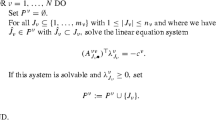Abstract
We consider nonlinear flow problems involving noncooperative agents, all active in the same network. To find Nash equilibria, we develop an algorithm that lends itself to decentralized computation and parallel processing. The algorithm, which proceeds in terms of iterative strategy adjustments, is, in essence, of subgradient type. One advantage of that type is the ease with which stochastic and nonsmooth data can be accommodated.
Similar content being viewed by others
References
M. Aoki, On some price adjustment schemes, Ann. Econ. Soc. Measure 3, 1974, 95–115.
W.B. Arthur, Yu.M. Ermol'ev and Yu.M. Kaniovski, Non-linear urn processes: Asymptotic behavior and applications, IIASA, Working Paper 85, 1987.
J.-P. Aubin and H. Frankowska,Set-Valued Analysis, Birkhaüser, Basel, 1990.
R.J. Aumann and S. Hart (eds.),Handbook of Game Theory, vol. I, North Holland, Amsterdam, 1992.
D.P. Bertsekas and J.N. Tsitsiklis,Parallel and Distributed Computation, Prentice-Hall International, London, 1989.
D.P. Bertsekas, P.A. Hosein and P. Tseng, Relaxation methods for network flow problems with convex arc costs, SIAM J. Control and Optim. 25,1987, 1219–1243.
A. Benveniste, M. Métivier and P. Priouret,Adaptive Algorithms and Stochastic Approximations, Springer, Berlin, 1990.
K. Binmore and P. Dasgupta, Game theory: A survey, inEconomic Organizations and Games, K. Binmore and P. Dasgupta, eds., Basil Blackwell, Oxford, 1986, pp. 1–45.
A. Cournot,Recherches sur les Principes Mathématiques de la Théorie des Richesses, 1838, English edition:Researches into the Mathematical Principles of the Theory of Wealth, Macmillan, New York, 1897.
S. Dafermos and A. Nagurney, Oligopolistic and competitive behavior of spatially separated markets, Regional Science and Urban Economics 17, 1987, 245–254.
Yu.M. Ermol'ev and S.P. Uryas'ev, Nash equilibrium inn-person games (in Russian), Kibernetika 3, 1982, 85–88.
Yu.M. Ermol'ev, Stochastic quasigradient methods, inNumerical Techniques for Stochastic Optimization, Yu. Ermol'ev and R.J-B Wets, eds., Springer, Berlin, 1989, pp. 141–185.
D. Fudenberg and D.M. Kreps, Learning mixed equilibria, Games and Economic Behavior 5, 1993, 320–367.
M. Gondran and M. Minoux,Graphes et Algorithmes, Editions Eyrolles, Paris, 1990.
P.T. Harker, Alternative models of spatial competition, Operations Research 34, 1986, 410–425.
P.T. Harker and J.-S. Pang, Finite-dimensional variational inequalities and nonlinear complementarity problems: A survey of theory, algorithms and applications, Mathematical Programming 48, 1990, 161–220.
A. Haurie and P. Marcotte, On the relationship between Nash-Cournot and Wardrop equilibria, Networks 15, 1985, 295–308.
H.J. Kushner and D.S. Clark,Stochastic Approximation Methods for Constrained and Unconstrained Systems, Applied Math. Sciences 26, Springer, Berlin, 1978.
A. Marcet and T.J. Sargent, Convergence of least squares learning mechanism in self-referential linear stochastic models, J. Economic Theory 48, 1989, 337–368.
F.H. Murphy, H.D. Sherali and A.L. Soyster, A mathematical programming approach for determining oligopolistic market equilibrium, Mathematical Programming 24, 1982, 92–106.
A. Nagurney,Network Economics, A Variational Inequality Approach, Kluwer Academic, Dordrecht, 1993.
J.F. Nash, Noncooperative games, Annals of Mathematics 54, 1951, 286–298.
B.T. Polyak,Introduction to Optimization, Optimization Software, Inc., New York, 1987.
H. Robbins and D. Siegmund, A convergence theorem for nonnegative almost surmartingales and some applications, inOptimizing Methods in Statistics, J. Rustagi, ed., Academic Press, New York, 1971, pp. 235–257.
R.T. Rockafellar,Convex Analysis, Princeton University Press, NJ, 1970.
R.T. Rockafellar,Network Flows and Monotropic Optimization, Wiley, New York, 1984.
J.B. Rosen, Existence and uniqueness of equilibrium point for concaveN-person games, Econometrica 33, 1965, 520–534.
J. Tirole,The Theory of Industrial Organization, MIT Press, Cambridge, 1988.
Author information
Authors and Affiliations
Additional information
This paper was written while the first author was visiting the Université de Perpignan. Support from Elf Petroleum, Université de Perpignan and NFR project Quantec 111039/410 is gratefully acknowledged.
Rights and permissions
About this article
Cite this article
Flåm, S.D., Horvath, C. Network games; adaptations to Nash-Cournot equilibrium. Ann Oper Res 64, 179–195 (1996). https://doi.org/10.1007/BF02187645
Issue Date:
DOI: https://doi.org/10.1007/BF02187645



